Could the Continents on Earth Ever Create a Supercontinent Again
How the next 'supercontinent' will class
(Image credit:
Getty Images
)
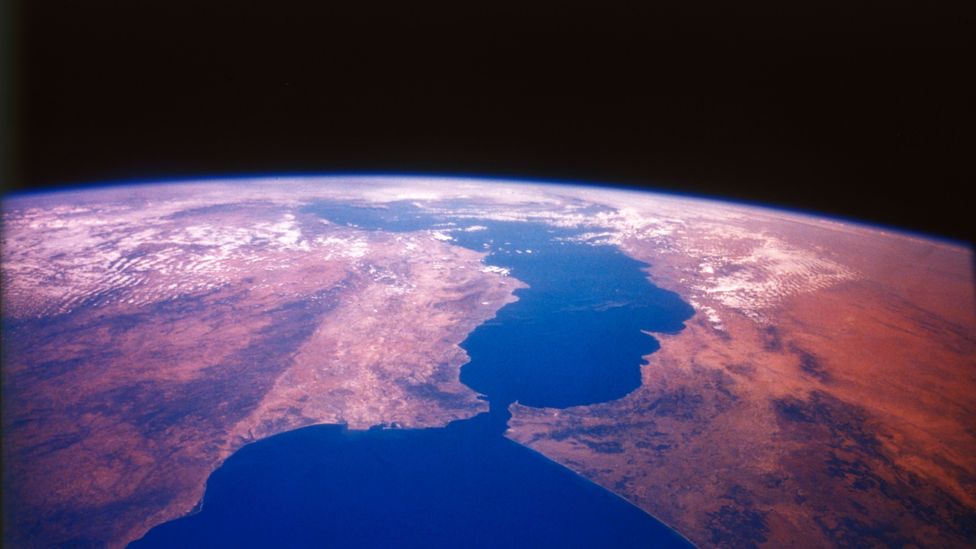
Information technology might seem that the world'due south landmasses are fixed, but equally Richard Fisher discovers, at that place are major changes coming.
North
Well-nigh 500 years agone, the Flemish cartographer Geradus Mercator produced one of the world's most important maps.
Information technology certainly wasn't the first endeavor at a world atlas, and it was not especially accurate either: Commonwealth of australia is absent, and the Americas are only roughly drawn. Since and so, cartographers have produced e'er-more precise versions of this continental arrangement, correcting for Mercator's errors, likewise the biases between hemispheres and latitudes created past his projection. Merely Mercator's map, along with others produced by his 16th-Century contemporaries, revealed a truly global flick of Earth's landmasses – a perspective that has persisted in people's minds ever since.
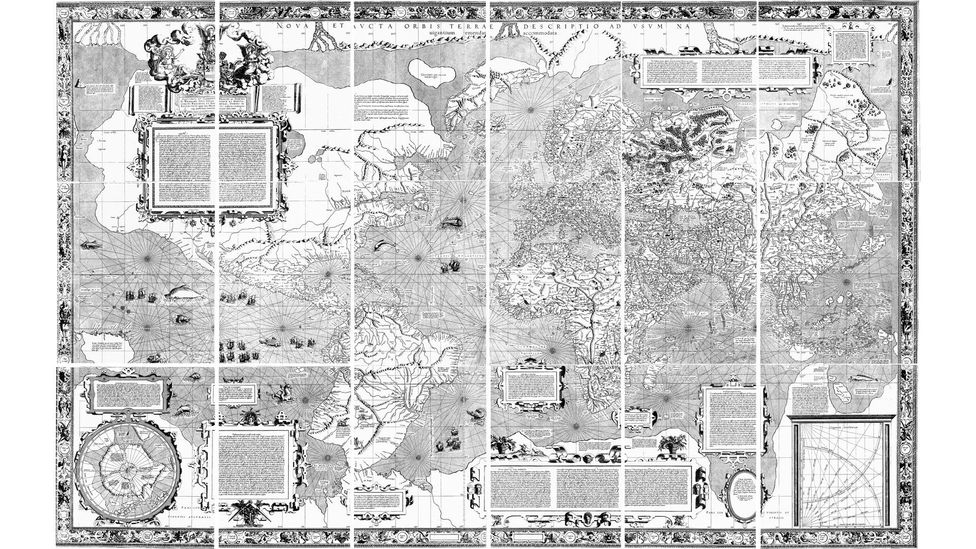
Mercator's original projection from 1569 (Credit: Wikimedia Commons)
What Mercator didn't know is that the continents have not e'er been bundled this way. He lived around 400 years before the theory of plate tectonics was confirmed.
When looking at the positions of the vii continents on a map, it'south like shooting fish in a barrel to presume that they are fixed. For centuries, human beings take fought wars and made peace over their share of these territories, on the assumption that their land – and that of their neighbours – has always been in that location, and ever volition be.
From the Globe'due south perspective, however, the continents are leaves drifting across a pond. And human being concerns are a raindrop on the leaf's surface. The seven continents were once assembled in a single mass, a supercontinent called Pangaea. And earlier that, there's prove for others stretching back over iii billion years: Pannotia, Rodinia, Columbia/Nuna, Kenorland and Ur.
Geologists know that supercontinents disperse and assemble in cycles: we're halfway through 1 at present. And so, what kind of supercontinent might lie in Earth'south future? How will the landmasses equally nosotros know them rearrange over the very long-term? It turns out that there are at least four different trajectories that could lie ahead. And they show that Earth'due south living beings will one day reside on a very different planet, which looks more like an alien world.
You may besides like:
- The missing continent that took 375 years to discover
- How to turn yourself into a fossil
- How cities will fossilise
For geologist Joao Duarte at the University of Lisbon, the path to exploring Earth's time to come supercontinents began with an unusual event in the past: an earthquake that struck Portugal one Saturday morn in November 1755. Information technology was amidst the most powerful quakes of the past 250 years, killing 60,000 people and sending a tsunami across the Atlantic Sea. What made it particularly odd was its location. "You should not have big earthquakes in the Atlantic," says Duarte. "It was foreign."
Earthquakes of this scale usually happen on or near major subduction zones, where oceanic plates plunge beneath the continents and are melted and consumed in the hot drapery. They involve collision and destruction. The 1755 quake, yet, happened forth a "passive" boundary, where the body of water plate underlying the Atlantic transitions smoothly into the continents of Europe and Africa.
In 2016, Duarte and colleagues proposed a theory for what might be going on: the stitches between these plates could be unravelling, and a major rupture may be looming. "Information technology could be a kind of infectious machinery," he explains. Or like the glass splintering between ii small holes in a machine windscreen. If so, a subduction zone could exist poised to spread out from the Mediterranean along western Africa and possibly all the way upward past Ireland and the UK, bringing volcanoes, mountain-edifice and earthquakes to these regions.
Duarte realised that, if this happens, information technology could lead to the Atlantic eventually closing. And if the Pacific continued to close as well – which is already occurring along the subducting "Ring of Fire" circling information technology – a new supercontinent would eventually form. He chosen information technology Aurica, named because the former landmasses of Australia and the Americas would sit at its middle.
It would expect like this:
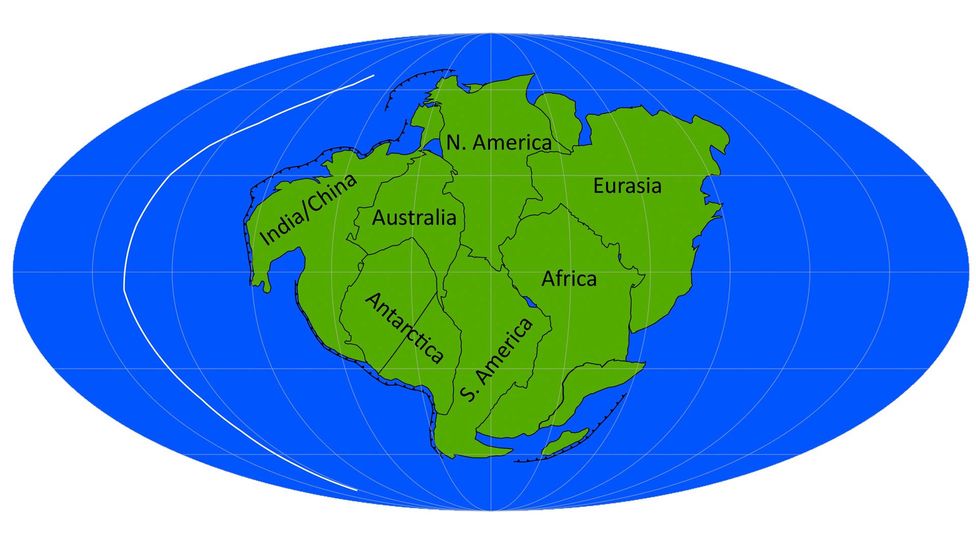
Aurica, the supercontinent that could grade if the Atlantic and Pacific closed (Credit: Davies et al)
Later Duarte published his proposal for Aurica, he wondered about other future scenarios. After all, his was not the merely supercontinent trajectory that geologists had proposed.
So, he began chatting with oceanographer Matthias Greenish at Bangor University in Wales. The pair realised they needed someone with the computational chops to create digital models. "That person had to be someone a picayune flake special, who didn't mind studying something that will never happen in man timescales," he explains. That turned out to exist his colleague Hannah Davies, some other geologist at Lisbon University. "My chore was to plow drawings and illustrations from past geologists into something that is quantitative, geo-referenced and in a digitised format," explains Davies. The idea was to create models that other scientists could build on and refine.
But it wasn't straightforward. "What we were nervous about is information technology's an incredibly bluish-sky topic. Information technology's not in the same kind of vein as a regular scientific newspaper," says Davies. "Nosotros wanted to say, 'Okay, nosotros understand this much about plate tectonics after 40 years or 50 years. And we sympathize this much about mantle dynamics, and all of the other components of the system. How far can we take that knowledge into the future?'"
This led to four scenarios. Also as modelling a more than detailed picture of Aurica, they explored three other possibilities, each projecting alee roughly 200-250 million years from now.
The outset was what could happen if the status quo continues: the Atlantic stays open and the Pacific closes. In this scenario, the supercontinent that forms will be chosen Novopangaea. "It is the most simple, and most plausible based on what we understand correct now," says Davies.
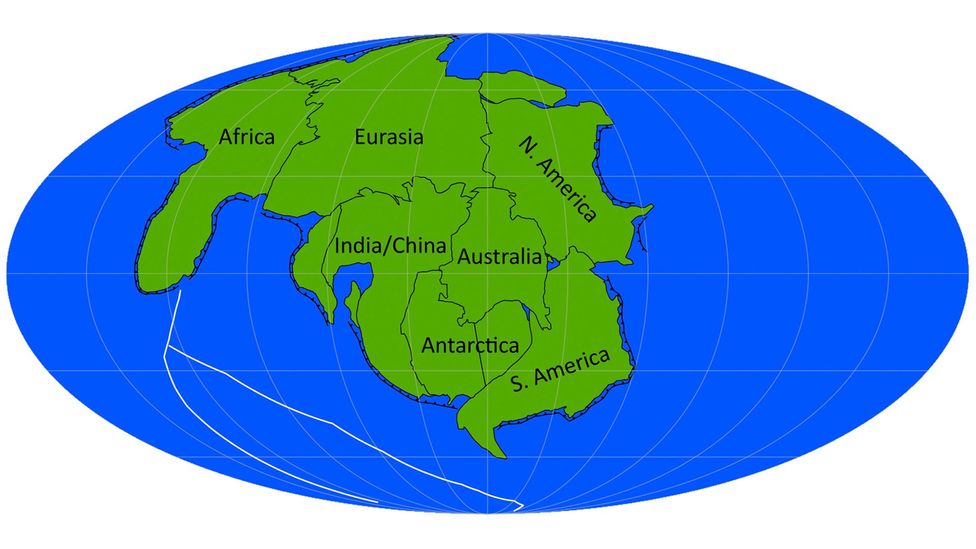
Novopangaea will form if known tectonic activity today continues with no surprises (Credit: Davies et al)
However, in that location could also be geological events in the future that atomic number 82 to dissimilar arrangements.
One case is a process called "orthoversion" where the Arctic Ocean closes and the Atlantic and Pacific remain open. This changes the ascendant orientations of tectonic spreading, and the continents drift due north, all arranging around the North Pole, except Antarctica.
In this scenario, a supercontinent called Amasia forms:
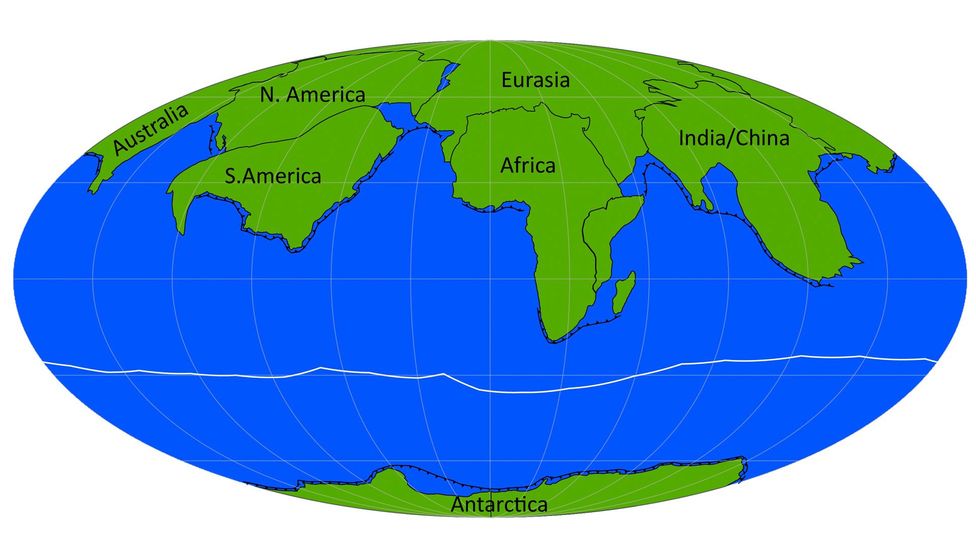
If Amasia forms, it'll exist because the continents drifted northwards (Credit: Davies et al)
Finally, it's likewise possible that the seafloor spreading in the Atlantic could wearisome downwards. In the heart of the bounding main, there'due south a giant ridge bisecting two plates, running through Iceland all the way down to the Southern ocean. Here, new lithosphere is forming, feeding out similar a conveyor belt. If this spreading slowed or stopped, and if a new subducting plate boundary formed alongside the east coast of the Americas, y'all'd get a supercontinent chosen Pangaea Ultima, which looks like an enormous atoll:
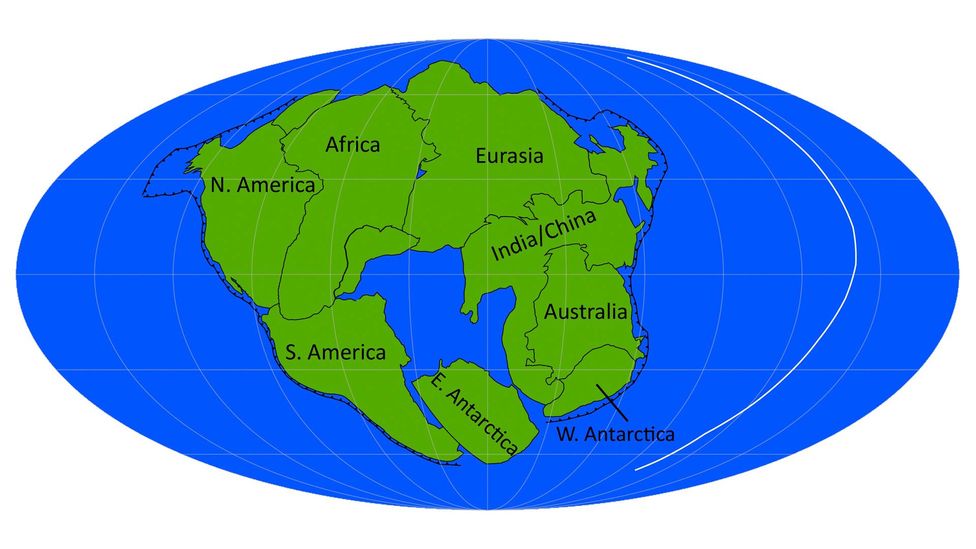
Pangaea Ultima is still surrounded past a huge sea, but has a central sea within it (Credit: Davies et al)
These four digital models at present hateful that geologists have a base to test other theories. For instance, the scenarios could help scientists to empathise the furnishings of different supercontinental arrangement on the tides, too as the climate of the deep futurity – what would the weather be like on a world with a massive ocean and behemothic landmass?
To model the climate of a supercontinent, "you lot cannot apply the IPCC [Intergovernmental Console on Climate Change] models, full terminate, because they are non designed to do that", says Duarte. "You cannot change the variables that you need to change."
The models of World's time to come supercontinents can also serve as a proxy for understanding the climate of exoplanets. "The future Earth is completely alien," says Davies. "If y'all were in orbit above Aurica, or Novopangaea, you probably wouldn't recognise it equally Earth, merely another planet that had like colours."
This insight led the trio to collaborate with Michael Way, a physicist at the Nasa Goddard Institute for Space Studies. He and his colleagues seek to written report climates on alien worlds by modelling the variations of our own over deep time. "Nosotros but have so many examples of what a temperate climate tin expect like. Well, nosotros accept one case to be honest: Earth, but we accept Globe through time," says Way. "We have the by scenarios, merely past moving to the future and using these wonderful tectonic models for the futurity, it gives us another ensemble to add to our collection."
You need such models because it can be hard to know what to look for when analysing potentially habitable exoplanets from afar. Ideally you want to know if a planet has a supercontinent cycle, because the presence of life and active plate tectonics may well exist entwined. The continental arrangement could as well impact the likelihood of liquid water. Through telescopes, you lot tin't run into the continents, and the atmospheric composition can merely be inferred. So, models of climate variations could reveal some indirect signature that astronomers could detect.
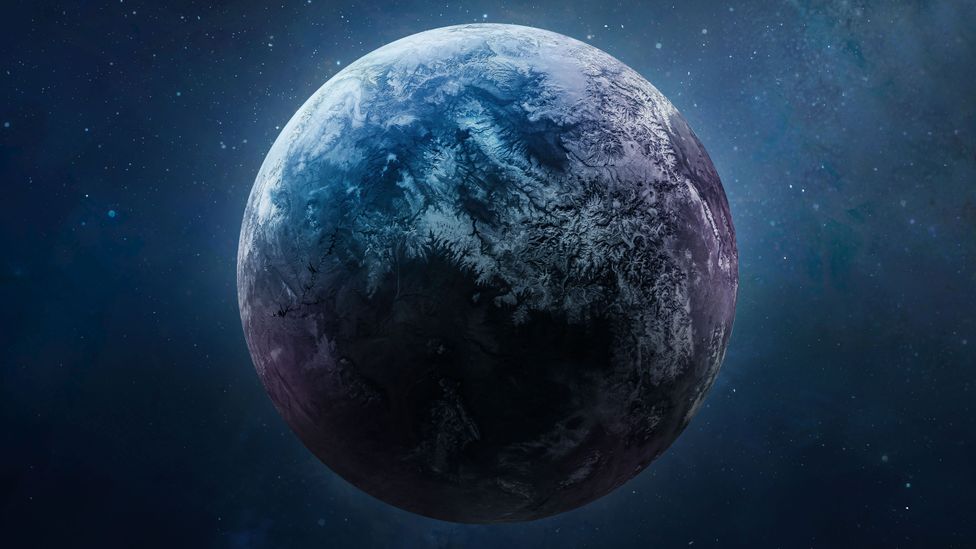
What kind of continental arrangement might rocky alien worlds have? (Credit: Getty Images)
Manner's modelling of the supercontinent climates – which took months using a supercomputer – revealed some hitting variations between the four scenarios. Amasia, for case, would lead to a much chillier planet than the rest. With land concentrated around the N Pole and the oceans less likely to bear warm currents to libation latitudes, water ice sheets would build upwards. Aurica, by dissimilarity, would be balmier, with a dry out core but coasts akin to Brazil's today, with more liquid water.
All this is helpful to know, because if an Globe-like exoplanet has plate tectonics, nosotros won't know which stage of the supercontinent cycle it is currently in, and therefore we will demand to know what to expect out for to infer its habitability. We shouldn't presume that the landmasses volition be dispersed, mid-bike, similar our ain.
Equally for our own planet's future, Davies acknowledges that the four supercontinent scenarios they have modelled are speculative, and there may be unanticipated geological surprises that change the outcome. "If I had a Tardis to go and see, I wouldn't be surprised if, in 250 million years, the supercontinent didn't await annihilation like any of these scenarios. There are so many factors involved," she says.
All the same, what can be said for certain is that the landmasses we have for granted volition one mean solar day rearrange into an entirely new configuration. Countries once isolated from one another volition exist close neighbours. And if Earth nevertheless hosts intelligent beings, they volition be able to travel between the ancient ruins of New York, Beijing, Sydney and London without ever seeing an ocean.
*Richard Fisher is a senior journalist for BBC Future and tweets @rifish
--
Join 1 one thousand thousand Future fans by liking us on Facebook , or follow us on Twitter or Instagram .
If you lot liked this story, sign up for the weekly bbc.com features newsletter , called "The Essential List" – a handpicked selection of stories from BBC Future , Culture , Worklife , Travel and Reel delivered to your inbox every Friday.
Source: https://www.bbc.com/future/article/20220401-how-the-next-supercontinent-will-form
Post a Comment for "Could the Continents on Earth Ever Create a Supercontinent Again"